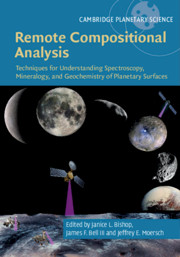 Remote Compositional Analysis
Remote Compositional Analysis Field and Airborne Measurements
from Part II - Terrestrial Field and Airborne Applications
Published online by Cambridge University Press: 15 November 2019
Visible and near-infrared reflectance spectroscopy using reflected sunlight is an ideal tool for remote detection of many compounds. Surfaces can be measured in the field at close range (mm), or from a distance with aircraft or spacecraft. The technology works throughout the Solar System. Advancements have recently been made in sensor calibration and atmospheric correction, enabling faster and more accurate calibration to surface reflectance (or apparent surface reflectance). Parallel to these advancements have been advancements in radiative transfer models, including a better understanding of the scattering effects of submicrometer particles and the ability to model those effects. There has also been progress in spectral analysis, including methods to rapidly analyze imaging spectrometer data to identify and map hundreds of compounds. Finally, with the advancements in computer technology, both in compute speed and in storage, analysis of very large imaging spectrometer data sets is now feasible in a relatively short time. With some additional development, imaging spectroscopy could be used in real time or near real time applications, including exploration of resources to autonomous robots such as spacecraft rovers searching for resources or life on remote planets and satellites.
To save this book to your Kindle, first ensure [email protected] is added to your Approved Personal Document E-mail List under your Personal Document Settings on the Manage Your Content and Devices page of your Amazon account. Then enter the ‘name’ part of your Kindle email address below. Find out more about saving to your Kindle.
Note you can select to save to either the @free.kindle.com or @kindle.com variations. ‘@free.kindle.com’ emails are free but can only be saved to your device when it is connected to wi-fi. ‘@kindle.com’ emails can be delivered even when you are not connected to wi-fi, but note that service fees apply.
Find out more about the Kindle Personal Document Service.
To save content items to your account, please confirm that you agree to abide by our usage policies. If this is the first time you use this feature, you will be asked to authorise Cambridge Core to connect with your account. Find out more about saving content to Dropbox.
To save content items to your account, please confirm that you agree to abide by our usage policies. If this is the first time you use this feature, you will be asked to authorise Cambridge Core to connect with your account. Find out more about saving content to Google Drive.